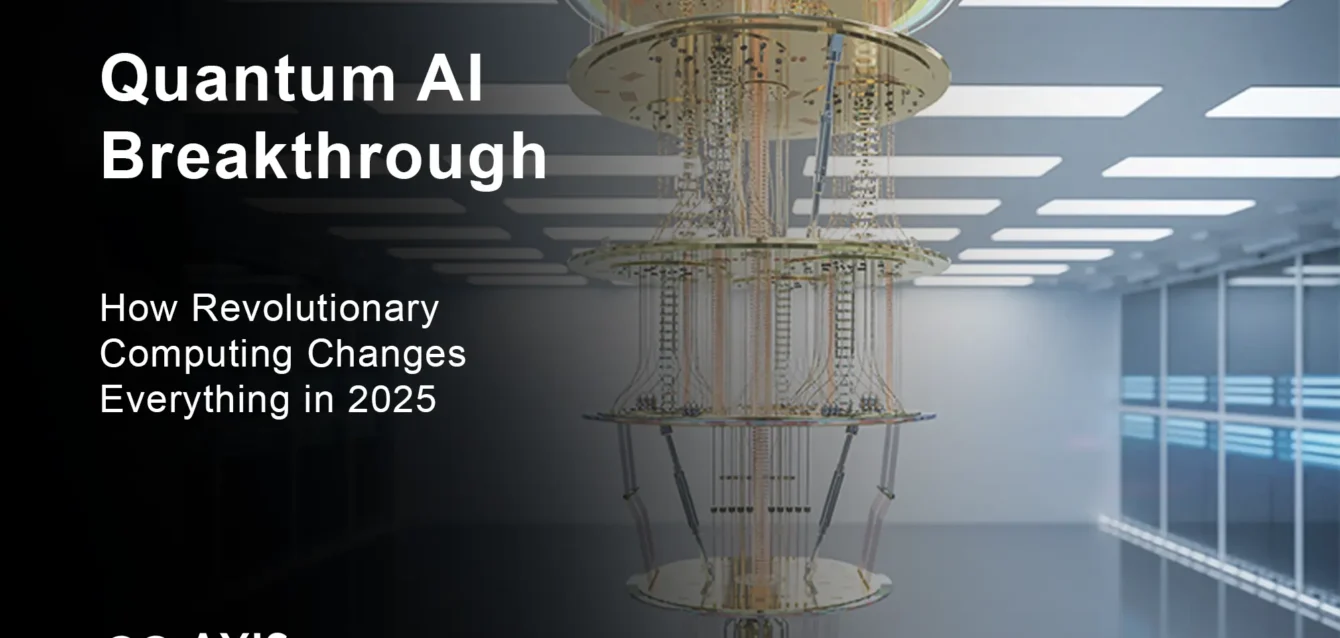Quantum AI
The fusion of quantum computing and artificial intelligence isn’t just another tech buzzword. It’s reshaping how we approach the most complex computational challenges of our time. Recent research demonstrates that quantum AI algorithms already outpace the fastest supercomputers in specific machine learning tasks, marking the beginning of a computational revolution that will touch every industry.
This isn’t about distant theoretical possibilities. Companies like Google, IBM, and emerging quantum startups are deploying quantum AI solutions today, achieving results that were unthinkable just two years ago. Google Quantum AI’s latest Willow chip represents a big step towards developing large-scale, error-corrected quantum computers, while practical applications are already emerging in drug discovery, financial modeling, and materials science.
Here’s what you’ll discover: how quantum AI works beyond the hype, real-world applications already transforming industries, and why this convergence might be the key to solving humanity’s most pressing challenges. Plus, we’ll explore the limitations that keep researchers up at night and the timeline for when quantum AI might reach its full potential.
Inhaltsübersicht
- What Is Quantum AI? Beyond the Basic Definition
- The Science Behind Quantum AI Algorithms
- Current Real-World Applications and Case Studies
- Quantum Machine Learning: The Technical Deep Dive
- Quantum Neural Networks vs Classical Networks
- Industry Applications and Market Impact
- Current Limitations and Technical Challenges
- The Future Roadmap: 2025-2035 Outlook
- Major Players and Investment Landscape
- Getting Started with Quantum AI Today
- Häufig gestellte Fragen
What Is Quantum AI? Beyond the Basic Definition {#what-is-quantum-ai}
Quantum AI represents the convergence of two transformative technologies: quantum computing’s exponential processing power and artificial intelligence’s pattern recognition capabilities. But here’s what most explanations miss: it’s not simply running AI on quantum computers.
Quantum artificial intelligence combines the principles of quantum mechanics with artificial intelligence to develop new algorithms and models that can leverage the unique properties of quantum computers. The real breakthrough lies in how quantum properties like superposition and entanglement create entirely new computational paradigms.
Think of classical computers as libraries where you can only read one book at a time. Quantum computers are like magical libraries where you can read all books simultaneously and have them cross-reference each other instantly. When you apply this to AI, you’re not just getting faster processing—you’re enabling fundamentally different types of learning and pattern recognition.
The Three Pillars of Quantum AI
Quantum Speedup: Quantum neural networks can achieve significantly higher effective dimensions than their classical counterparts and train to lower loss values in fewer iterations. This isn’t just about raw speed; it’s about reaching solutions that classical systems simply cannot achieve.
Enhanced Pattern Recognition: Quantum systems can identify patterns in data that exist in higher-dimensional spaces, where classical algorithms fail. This capability is particularly powerful for complex optimization problems and unsupervised learning tasks.
Exponential Scaling: While classical maschinelles Lernen models scale linearly with increased complexity, quantum AI systems can scale exponentially, making previously impossible problems suddenly tractable.
How Quantum AI Differs from Classical AI
The fundamental difference lies in information processing. Classical AI processes information sequentially, even when parallelized across multiple cores. Quantum AI processes information in superposition, allowing for simultaneous exploration of multiple solution paths.
Quantum computers can run powerful AI that works like the brain through transformer architectures adapted for quantum hardware. This brain-like parallel processing enables quantum AI to tackle problems where the solution space is too vast for classical exploration.
The Science Behind Quantum AI Algorithms {#quantum-ai-science}
Understanding quantum AI requires grasping how quantum mechanical properties translate into computational advantages. Let’s break down the core principles that make quantum AI fundamentally different.
Quantum Superposition in AI Context
Superposition allows quantum bits (qubits) to exist in multiple states simultaneously. In AI applications, this means a quantum algorithm can evaluate multiple hypotheses at once rather than testing them sequentially. Qubits can represent and process more complex information than a classical bit because of superposition and entanglement.
For machine learning, this translates to exploring vast parameter spaces simultaneously during training. Instead of gradient descent finding one local minimum, quantum algorithms can explore multiple regions of the loss landscape concurrently.
Quantum Entanglement for Enhanced Learning
Entanglement creates correlations between qubits that have no classical analog. In AI systems, entangled qubits can represent complex relationships in data that would require exponentially more classical resources to capture.
Entangled qubits can be manipulated collectively, allowing parallel processing of information beyond classical computing capabilities. This enables quantum AI systems to model correlations in high-dimensional data more efficiently than any classical approach.
Quantum Interference and Optimization
Quantum interference allows quantum algorithms to amplify correct answers while canceling out incorrect ones. This principle is crucial for quantum optimization algorithms used in machine learning.
Quantum algorithms can exploit structure in Fourier space directly, using quantum Fourier transforms to detect hidden patterns in data exponentially faster than classical methods.
Practical Implementation: Hybrid Quantum-Classical Systems
Most current quantum AI implementations use hybrid approaches. Hybrid quantum-classical workflows combine classical pre- or post-processing with quantum computation, demonstrating robustness to noise and modest performance advantages in high-noise settings.
These hybrid systems leverage classical computers for data preparation and quantum processors for the computationally intensive core algorithms. This approach allows researchers to achieve quantum advantages today while working within the limitations of current quantum hardware.
Current Real-World Applications and Case Studies {#real-world-applications}
Quantum AI has moved beyond laboratory demonstrations into practical applications solving real business problems. Here are the areas where quantum AI is already making an impact.
Financial Services Revolution
JPMorgan Chase uses quantum computers to test algorithms for financial tasks like option pricing and risk analysis. The bank has reported significant improvements in portfolio optimization speed and accuracy compared to classical methods.
Portfolio optimization represents an ideal quantum AI application because it involves exploring vast combinations of investment options simultaneously. Quantum algorithms can evaluate risk-return profiles across thousands of assets in parallel, identifying optimal allocations that classical systems miss.
Beschleunigung der Medikamentenentdeckung
Pharmaceutical companies like Roche collaborate with quantum computing companies to develop new drugs through quantum simulations that model molecular interactions more accurately than classical computers.
The complexity of molecular interactions makes drug discovery a natural fit for quantum AI. Quantum systems can simulate protein folding and drug-target interactions at unprecedented scales, potentially reducing drug development timelines from decades to years.
Materials Science Breakthroughs
Researchers are exploring quantum simulations to discover new materials for energy storage, such as quantum batteries with higher capacity and longer lifespan. This application leverages quantum AI’s ability to model quantum mechanical systems directly.
Logistics and Optimization
Volkswagen experimented with a quantum annealer to optimize taxi routes in Beijing to reduce traffic congestion. The results showed measurable improvements in route efficiency compared to classical optimization algorithms.
Supply chain optimization, scheduling, and resource allocation problems involve combinatorial complexity that grows exponentially with problem size. Quantum AI algorithms can find near-optimal solutions where classical methods struggle.
Cybersecurity Enhancement
Quantum encryption algorithms create virtually unbreakable codes, while quantum AI’s advanced analytics can identify patterns and anomalies in large datasets for proactive threat detection.
Quantum Machine Learning: The Technical Deep Dive {#quantum-machine-learning}
Quantum machine learning (QML) represents the practical application of quantum computing principles to learning algorithms. Let’s explore how these systems work and why they offer advantages over classical approaches.
Quantum Data Encoding
The first challenge in QML involves encoding classical data into quantum states. Quantum machine learning uses qubits and quantum circuits to encode data, along with quantum interference and quantum gates to process complex data much faster than classical machines.
Data encoding strategies include:
Amplitude Encoding: Classical data values are encoded as amplitudes of quantum states, allowing exponential compression of information.
Basis Encoding: Each classical bit maps directly to a qubit state, providing a straightforward but less efficient encoding.
Angle Encoding: Data values are encoded as rotation angles of qubits, enabling continuous value representation.
Variational Quantum Algorithms
Variational quantum algorithms use a classical computer to optimize parameters for quantum state preparation while using quantum computers for actual state preparation and measurement.
These algorithms form the backbone of current QML implementations. The variational approach allows quantum AI systems to work within the constraints of noisy intermediate-scale quantum (NISQ) devices while still achieving quantum advantages.
Quantum Kernel Methods
Scientists have demonstrated quantum speedup in kernel-based machine learning using a quantum photonic circuit and machine learning algorithm, showing increased speed, accuracy, and efficiency over classical methods.
Quantum kernel methods map classical data to high-dimensional quantum feature spaces where linear separation becomes possible. This approach has shown particular promise for classification tasks where classical methods struggle with complex decision boundaries.
Error Mitigation in Quantum ML
AlphaQubit, an AI-based decoder, identifies quantum computing errors with state-of-the-art accuracy, helping make quantum technology more reliable. Error correction remains crucial for practical quantum AI applications.
Current error mitigation strategies include:
- Quantum error correction codes
- Error mitigation through postprocessing
- Noise-resilient algorithm design
- Hybrid classical-quantum error handling
Quantum Neural Networks vs Classical Networks {#quantum-neural-networks}
The comparison between quantum and classical neural networks reveals fundamental differences in architecture, training, and capability.
Architectural Differences
Quantum neural networks combine classical neural networks and parametrized quantum circuits, loading classical data into quantum states and processing it with quantum gates parametrized by trainable weights.
Classical neural networks process information through layers of interconnected nodes, with each connection having an adjustable weight. Quantum neural networks replace these nodes with quantum gates and use quantum entanglement to create more complex connection patterns.
Training Advantages and Challenges
Quantum neural networks can achieve significantly higher effective dimensions than classical counterparts and train to lower loss values in fewer iterations. However, this advantage comes with unique challenges.
Barren Plateaus: Most initial parameters are trapped on a “plateau” of almost zero gradient, approximating random wandering rather than gradient descent, making the model untrainable. This fundamental challenge affects most deep quantum algorithms.
Gradient Vanishing: The quantum space exponentially expands as qubits grow, causing observations to concentrate around mean values with exponentially small gradients.
Performance Comparisons
Quantum transformers could perform tasks that are elementary for young children but that classical computers struggle with, using attention mechanisms that leverage quantum parallelism.
Recent studies show quantum neural networks excel in specific domains:
- Pattern recognition in high-dimensional data
- Optimization problems with quantum structure
- Simulation of quantum systems
- Feature mapping in kernel methods
Practical Implementation
Traditional neural networks can be transformed into neuromorphic quantum models using standard laptops, enabling anyone with undergraduate-level machine learning knowledge to create quantum-inspired models.
This accessibility breakthrough means quantum AI development is no longer limited to specialized quantum computing facilities.
Industry Applications and Market Impact {#industry-applications}
The quantum AI market is experiencing unprecedented growth, with applications spanning multiple industries and transforming business operations.
Market Size and Growth Projections
The global Quantum Artificial Intelligence market size is expected to reach $1.49 billion by 2029 at a 38.7% growth rate. This explosive growth reflects the transition from research to practical applications.
Healthcare and Pharmaceutical Innovation
AI and machine learning accelerate quantum hardware development through AI-driven material discovery, while quantum computing offers transformative leaps in computational power for AI model training.
Healthcare applications include:
- Drug discovery optimization
- Personalized medicine algorithms
- Medical imaging enhancement
- Genomic analysis acceleration
Financial Technology Transformation
Quantum vendors sold $854 million worth of computer systems in 2024, compared with $494 million in 2023, doubling sales of full-stack quantum computing systems from 2021 to 2024.
Financial applications driving adoption:
- High-frequency trading algorithms
- Risk management optimization
- Fraud detection systems
- Cryptocurrency security protocols
Manufacturing and Supply Chain
Quantum computing can accelerate material discovery, improve modeling of complex systems, and optimize production processes for sustainability and climate tech applications.
Manufacturing benefits include:
- Production line optimization
- Quality control enhancement
- Predictive maintenance systems
- Supply chain risk mitigation
Energy and Climate Solutions
Quantum AI applications in energy focus on:
- Smart grid optimization
- Renewable energy forecasting
- Carbon capture modeling
- Battery technology advancement
Current Limitations and Technical Challenges {#limitations-challenges}
Despite promising advances, quantum AI faces significant technical and practical limitations that researchers are actively addressing.
Hardware Constraints
Quantum computers are very slow and only very short calculations can be carried out without breakdowns. Current quantum processors suffer from:
Coherence Time Limitations: Quantum states decay rapidly, limiting computation duration Fehlerquoten: Current error rates of 0.1-1% per operation remain too high for many applications Limited Qubit Count: Most systems have fewer than 1000 qubits, constraining problem size
Algorithmic Challenges
Every time you run a quantum algorithm, the output will be different, requiring many repetitions to reconstruct the distribution accurately, increasing overhead.
Key algorithmic limitations include:
- Probabilistic outputs requiring statistical sampling
- Limited quantum algorithm portfolio
- Classical preprocessing overhead
- Integration complexity with existing systems
Scalability Issues
Scalable quantum systems with sufficient qubits are exceptionally technically challenging, and current quantum computers are too error-prone to solve truly complex problems.
Scalability challenges encompass:
- Physical qubit connectivity constraints
- Control system complexity
- Error correction overhead
- Manufacturing consistency
Economic and Practical Barriers
Quantum computing demands substantial resources like power and cooling, with significant hardware development challenges remaining.
Practical barriers include:
- High infrastructure costs
- Specialized expertise requirements
- Limited software ecosystem
- Integration with classical systems
The Future Roadmap: 2025-2035 Outlook {#future-roadmap}
The quantum AI landscape is evolving rapidly, with clear milestones and breakthrough predictions shaping the next decade.
Near-Term Developments (2025-2028)
During the 2025-2028 period, quantum models will remain within the Early and Advanced NISQ phase, where hybrid cloud quantum setups and classical-quantum inference loops will dominate.
Expected developments include:
- Improved error mitigation techniques
- Larger-scale hybrid systems
- Commercial quantum AI services
- Industry-specific quantum algorithms
Mid-Term Breakthroughs (2028-2032)
Google’s head of quantum AI indicates that commercialized quantum computing applications will be running within five years in materials science, healthcare, and energy.
Anticipated milestones:
- Fault-tolerant quantum computers
- Quantum AI cloud platforms
- Enterprise-grade applications
- Standardized quantum AI frameworks
Long-Term Vision (2032-2035)
IBM expects quantum computing to be foundational technology with massive gains in error correction and coherence speeds by 2030.
Long-term predictions include:
- Universal quantum computers
- Quantum artificial general intelligence
- Quantum internet infrastructure
- Transformed industries and business models
Investment and Development Trends
The quantum computing industry continues building bench strength, with venture capital investments cresting $2 billion in 2025.
Investment focuses:
- Hardware improvement initiatives
- Software development platforms
- Talent acquisition and training
- Industry partnership programs
Major Players and Investment Landscape {#major-players}
The quantum AI ecosystem includes established tech giants, specialized startups, and government initiatives driving innovation.
Technology Leaders
Google Quantum AI: Google Quantum AI’s latest Willow quantum chip represents a big step towards developing large-scale, error-corrected quantum computers. Google leads in quantum supremacy demonstrations and practical quantum AI applications.
IBM Quantum: IBM announced a 2029 delivery date for its “large-scale, fault-tolerant” quantum computer, IBM Quantum Starling, expected to perform 20,000 times more operations than current systems.
Microsoft Azure Quantum: Microsoft’s Majorana 1 chip is billed as the first-ever quantum processing unit powered by a topological core, designed to scale to a million qubits on a single chip.
Emerging Companies
QC Ware’s Prometheum platform is accessible as Software as a Service on AWS Marketplace, designed to explore new medications, chemicals, and materials.
Notable emerging players include:
- Rigetti Computing: Focus on quantum cloud services
- IonQ: Trapped-ion quantum systems
- Xanadu: Photonic quantum computing
- D-Wave: Quantum annealing applications
Investment Landscape
The quantum computing industry stacked $854 million in computer system sales in 2024, with venture capital investments reaching $2 billion in 2025.
Key investment areas:
- Quantum hardware development
- Software and algorithm research
- Error correction technologies
- Commercial application development
Getting Started with Quantum AI Today {#getting-started}
You don’t need a quantum computer to begin exploring quantum AI. Multiple platforms and resources enable learning and experimentation today.
Cloud-Based Quantum Platforms
IBM Qiskit: Free access to quantum computers through IBM Quantum Network Google Cirq: Open-source quantum computing framework Microsoft Q#: Quantum development kit integrated with Azure Amazon Braket: Quantum computing service with multiple hardware options
Pädagogische Ressourcen
Google offers a free introduction to quantum error correction through their Coursera course, designed for everyone from curious undergrads to seasoned software engineers.
Recommended learning paths:
- Quantum computing fundamentals
- Linear algebra and complex numbers
- Machine learning prerequisites
- Quantum programming languages
Practical Steps to Begin
- Start with Classical ML: Build strong foundations in classical machine learning
- Learn Quantum Basics: Understand superposition, entanglement, and quantum gates
- Practice with Simulators: Use quantum simulators before accessing real hardware
- Join Communities: Participate in quantum AI conferences and online forums
- Experiment with Hybrid Algorithms: Begin with quantum-classical hybrid approaches
Development Tools and Frameworks
Popular quantum AI frameworks include:
- PennyLane: Quantum machine learning library
- TensorFlow Quantum: TensorFlow integration for quantum ML
- Qiskit Machine Learning: IBM’s quantum ML toolkit
- Cirq: Google’s quantum computing framework
FAQ: AI Quantum {#faq}
What is the difference between quantum computing and quantum AI?
Quantum computing refers to the hardware and algorithms that use quantum mechanical properties for computation. Quantum AI specifically applies quantum computing to artificial intelligence problems, combining quantum algorithms with machine learning techniques to solve AI tasks more efficiently.
Can quantum AI replace classical AI completely?
No, quantum AI is not a replacement but rather a complement to classical AI. Hybrid quantum-classical workflows currently demonstrate the most practical advantages, combining the strengths of both approaches. Classical AI will continue handling many tasks efficiently, while quantum AI addresses specific problems where quantum advantages exist.
How close are we to practical quantum AI applications?
We’re already seeing practical applications today. Quantum AI algorithms have demonstrated speedup over classical methods in kernel-based machine learning using current hardware. However, widespread adoption will require continued hardware improvements and algorithm development over the next 5-10 years.
What skills do I need to work in quantum AI?
Essential skills include strong mathematics (linear algebra, probability, complex numbers), classical machine learning expertise, quantum computing fundamentals, and programming experience with quantum frameworks like Qiskit or Cirq. Physics background helps but isn’t strictly necessary.
Which industries will benefit most from quantum AI?
Financial institutions, pharmaceutical companies, materials science researchers, and cybersecurity applications show the most immediate potential for quantum AI benefits. These industries deal with optimization problems and data analysis tasks that align well with current quantum advantages.
What are the main challenges holding back quantum AI adoption?
Current limitations include hardware constraints (error rates, coherence times), limited quantum algorithms for specific problems, high costs, and the need for specialized expertise. Error correction and scalability remain the primary technical challenges.
How can businesses prepare for quantum AI adoption?
Businesses should start by identifying optimization and machine learning problems that might benefit from quantum approaches, building internal quantum literacy through training programs, partnering with quantum computing companies for pilot projects, and monitoring quantum AI developments in their industry.
Will quantum AI enable artificial general intelligence?
While quantum AI may accelerate certain AI capabilities, it’s unclear whether it will directly enable artificial general intelligence. Quantum neural networks show promise for specific tasks but face fundamental challenges like barren plateaus that need resolution before achieving AGI-level capabilities.
Unterm Strich: Quantum AI represents a paradigm shift in computational capability, moving from theoretical possibility to practical reality. While current applications focus on specific optimization and machine learning problems, the technology’s exponential scaling potential suggests transformative impacts across industries within the next decade.
Success in quantum AI requires understanding both its revolutionary capabilities and current limitations. Organizations that begin exploring quantum AI applications today—through cloud platforms, hybrid algorithms, and strategic partnerships—will be best positioned to leverage this technology as it matures. The question isn’t whether quantum AI will transform how we solve complex problems, but how quickly businesses and researchers can adapt to harness its unprecedented potential.





